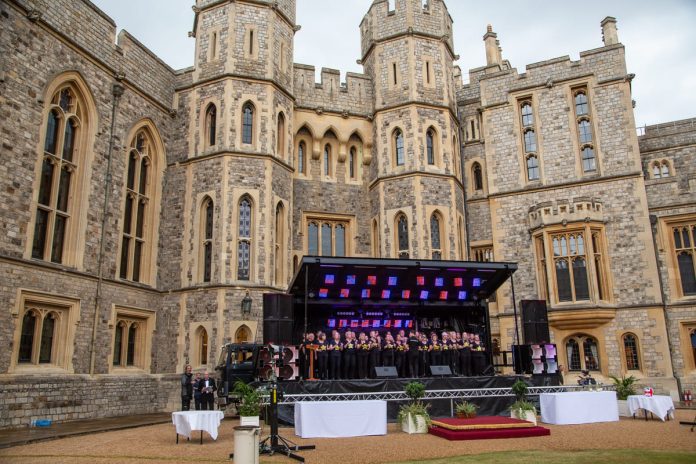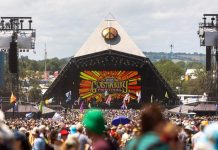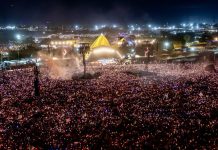Andrew Teverson, Managing Director of The Stage Bus, on the misconceptions surrounding solar power – and how you can measure the power consumption of your event.
Every single mobile stage in the Stage Bus fleet is 100% solar powered – but I don’t always tell people that straight away.
You might think that, in 2022, shouting about your sustainability credentials as loud as you possibly can is a no-brainer. But I’ve found people sometimes still have misconceptions about solar power, and what can be achieved with it. It’s for that reason that I don’t always lead with solar: I don’t want The Stage Bus to be ‘the green choice’ for event entertainment, I want us to be the best choice for event entertainment full stop, which just so happens to be better for the environment.
Power consumption is a huge factor in measuring the sustainability of any event. Is your event powered by generators? What kind of fuel is going into those generators, and are you using them as efficiently as possible? Many people don’t realise just how much power is wasted when generators are left to idle – a phenomenon the media has coined ‘vampire power’.
Real power efficiency doesn’t just start with choosing the best equipment, but also with designing and programming systems for lighting and sound that give you a lot of impact with very little power usage. I’ve had people tell me in the past that it’s not possible to put on a show for 1,000 people using solar power because they have preconceived ideas of how much power is needed for lighting and sound. That is if you’ll pardon my French, complete rubbish. Plugging into the mains, The Stage Bus could run a 5-8,000 person stage on a domestic power supply from your living room.
Many events go over the amount they actually need when it comes to power. While it makes sense to go over rather than under, it is all too common that events are specced with 25, 40 or even 80 kva generators when a 10 probably would have sufficed. Often this is because nobody has taken the time to measure power consumption.
So, what are some things you should consider when thinking about your event’s power consumption?
When you’re thinking about the power consumption of your event, there are a number of factors that you should be considering, before, during, and even after the event. Firstly, it’s worth looking at the maximum power draw of all of your equipment, and developing an understanding of what equipment uses lots of power and what doesn’t – for example, you can leave a laptop on all day and it’s going to be fine, but things like lights and amplifiers produce a lot of waste heat, which means they’re going to be using a lot more power.
It’s important to focus on reducing the consumption of your heavy-draw items. While it’s tempting to try and cut consumption across the board, you’re going to be wasting your time on some things, and you’re only really going to see the difference when you start thinking about the big things. For example, you can think about the difference between a tungsten lamp or an LED lamp, and decide whether the higher-powered piece of equipment is actually worth the extra power usage.
While you’re thinking about the draw of your equipment, it’s also worth bearing in mind the difference between a piece of equipment’s constant load and its peak load. A lot of people see the peak load number and think that’s the amount of power they’ll need, but this isn’t always the case. For example, if you’re powering a catering van, with heating elements running at full whack for a whole day, that’s probably going to need the full power limit, but an amplifier is very unlikely to ever hit that maximum power draw.
It’s a good idea to make sure that things like PA systems are properly limited to stop sudden very large power draws. Pieces of equipment that aren’t likely to hit their peak power draw often can cause sudden massive power draws if they do near their peak, which can cause issues with other electrical equipment in the system, but by properly limiting your equipment you can ensure that it’s not going to demand a sudden massive influx of power, keeping the rest of your equipment running smoothly.
While we’re thinking about PA systems, it’s also worth reminding people that the efficiency of a system isn’t one singular thing. To determine the efficiency of a PA system, you’re actually looking at the efficiency of the speakers and the amplifiers and the positioning of the equipment. This is something that can be hard to find, as many manufacturers either don’t publish efficiency data at all and those that do make it difficult to access. This is why it’s always important to have a proper understanding of the efficiency of your equipment.
With regard to the positioning of equipment, this is a good opportunity to mention the importance of making sure the power you’re using is actually going where you need it to and doing so effectively. If your speakers aren’t directed and positioned properly, you’re going to need more speakers and therefore more power to play to a crowd that you could’ve played to with much less in the way of power consumption if you’d properly directed your equipment. Wasting energy sending power where it isn’t needed is a textbook example of power inefficiency.
In the same vein, outdoor heaters for bars are a power consumption disaster, dumping heat into the atmosphere and not accomplishing much for the cost of a huge amount of power. Event organisers should get into the habit of asking themselves, “Do I really need this?” and considering alternative solutions that might consume less power.
Transport is another area that can use massive amounts of power. It’s easy to think of an event’s power consumption purely as energy usage at and during the event, but that ignores some significant factors. For one, it’s better to have a 60kva piece of equipment that came from a mile down the road than a 10kva piece of equipment that came from 200 miles away, even though conventional wisdom would suggest that the 10kva set would use less power. It’s also good to think about how suppliers and attendees are getting to your event. Ideally, people will be travelling to your event by public transport, or even walking or cycling. You can encourage this behaviour by ensuring that your event is held in a location with good public transport links, having suitable storage space for bikes, or even laying on shuttle bus services. In some cases, it’s impossible to avoid bringing a vehicle, but you should encourage people to car share, or use one larger vehicle instead of multiple smaller ones.
When your event is still at the planning stage, you should estimate how much power you’re going to use, and then measure power usage throughout the event. This allows you to see where your estimations were correct, and where they were off, which gives you an idea of what to improve on for next time. Sustainability doesn’t happen overnight, it’s a process. At The Stage Bus, we’ve spent over 15 years developing our business in a sustainable way, and we think we’ve got pretty good at it, but there have been learning curves and bumps in the road. Your event will have these too, but don’t let that dissuade you. Any progress is a positive step forward, and the more you learn and think about how your event can be made sustainable, the more progress you’ll make.





